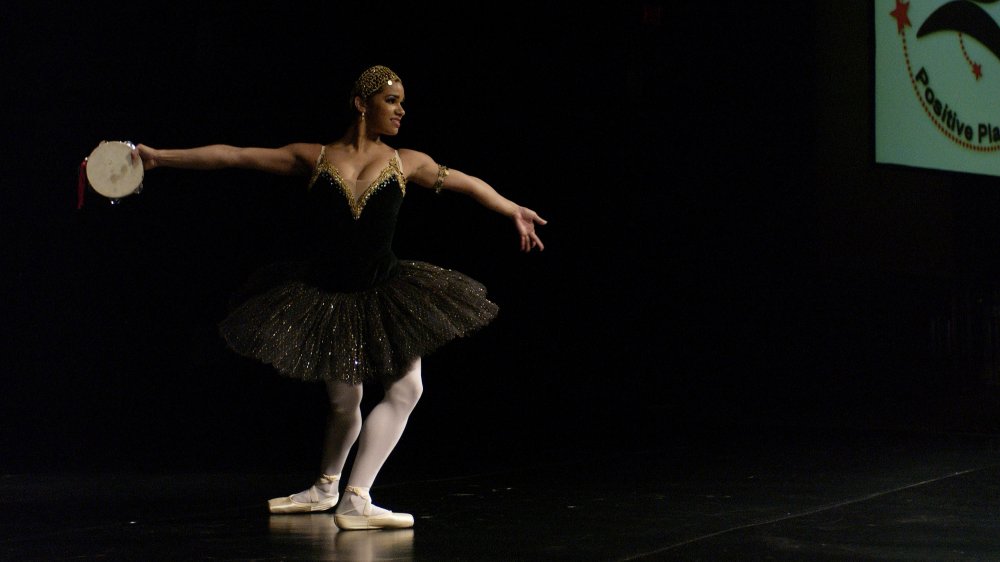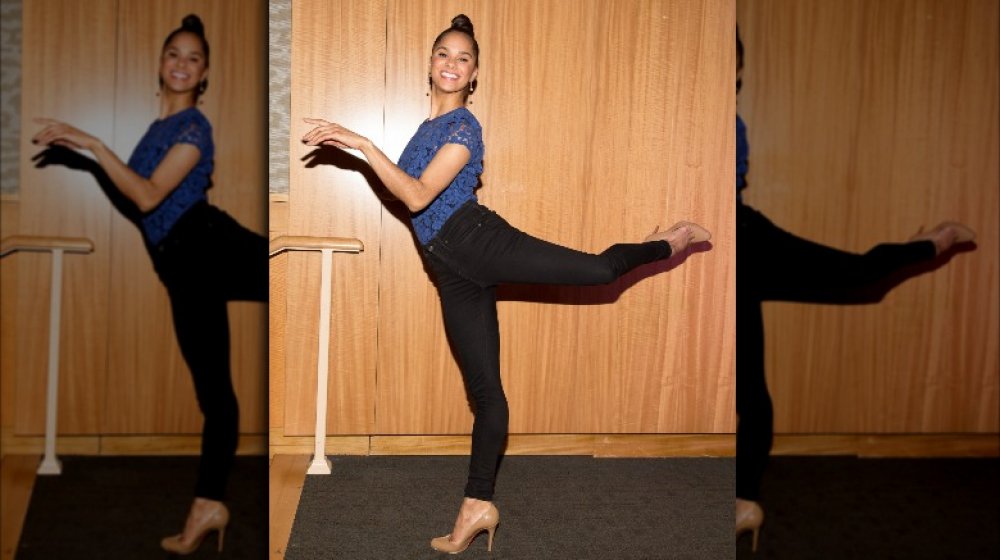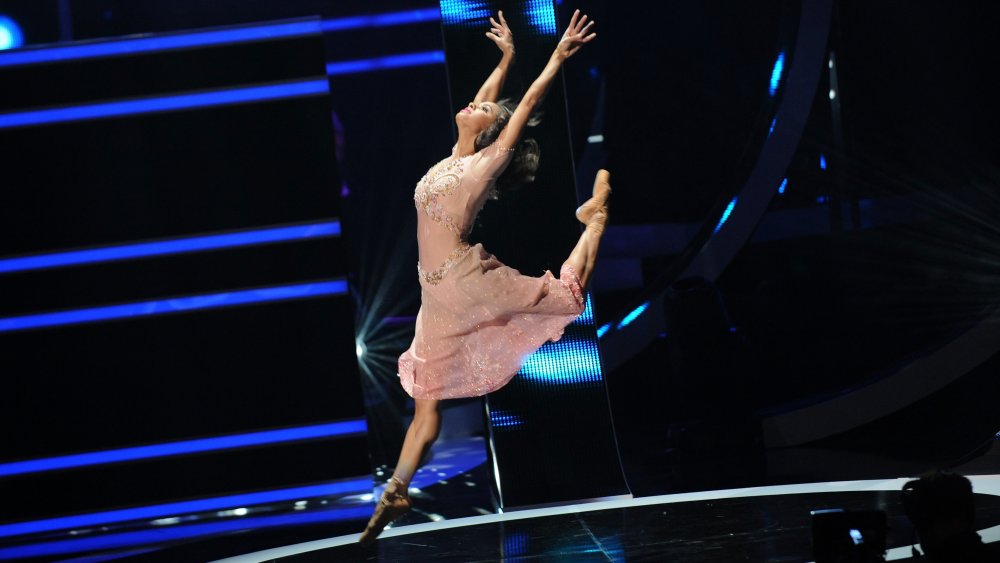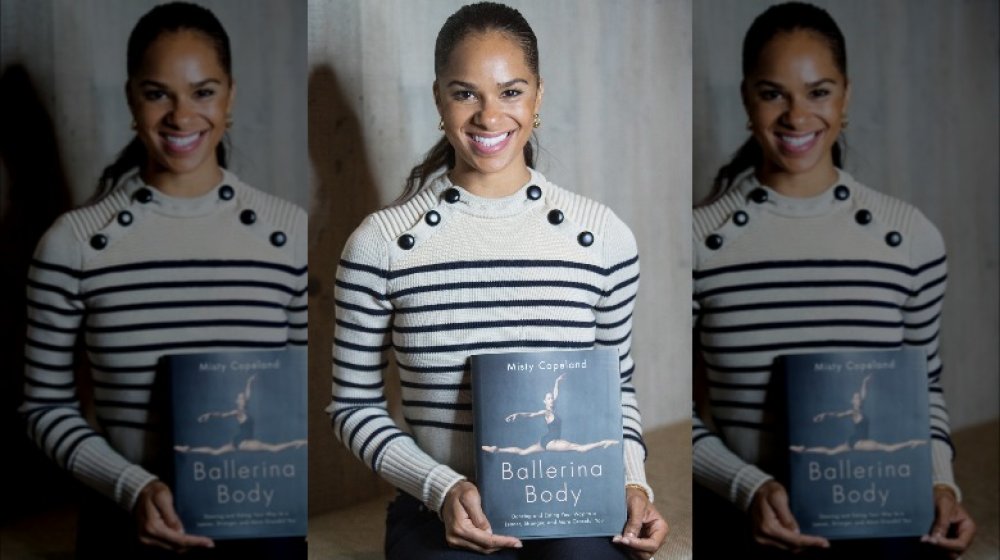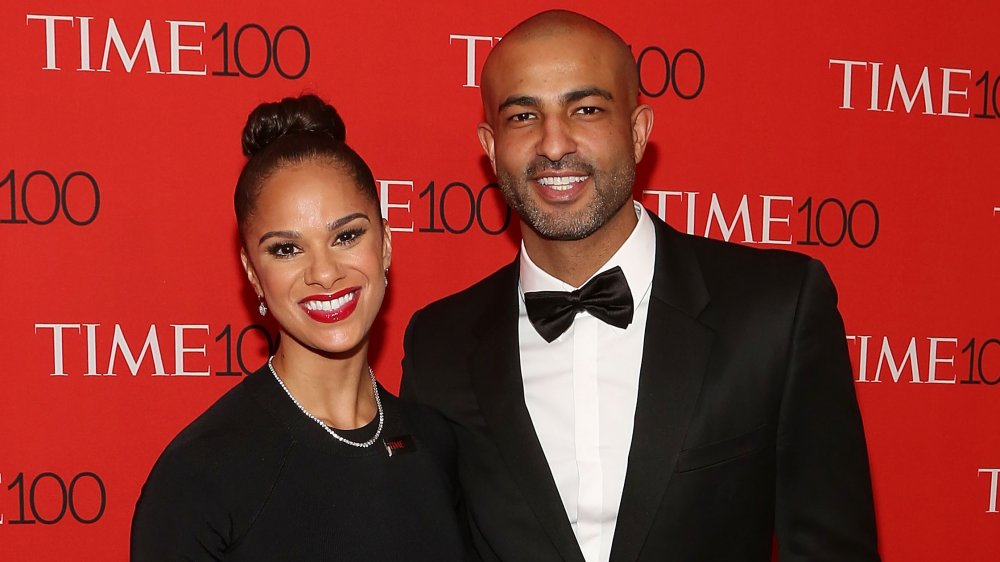The Untold Truth Of Misty Copeland
You may recognize Misty Copeland from the stage as one of the world's most celebrated dancers — or onscreen as the Ballerina Princess from 2018's The Nutcracker and the Four Realms. She's a true inspiration to anyone who aspires to be a professional dancer, to people of color who face ingrained systems of racism, and to anyone who aims to overcome daunting circumstances. If that sounds like high praise, it's no higher than the kind of spectacular grand jeté that this ballerina can perform.
When she was just 24 years old, "Copeland became only the second black soloist in the history of the American Ballet Theatre, the most prestigious company in North America," according to ESPN. While that was a stunning opportunity and a well-deserved accomplishment, the dancer herself reflected, "It was hard to survive. I really grew up in front of a lot of people."
That certainly wasn't the start of her path or the beginning of Copeland's struggles. "For millions of Americans, Copeland's journey to the pinnacle of her profession is an archetypal story of triumph over adversity," The Guardian notes ... and for good reason. This dancer has faced more hardships than you might imagine. However, she's also enjoyed the benefits of her hard work and stunning talent. Frankly, there are plenty of details about Copeland's life that will surprise you — so let's fish dive right in!
Misty Copeland's unstable childhood and one life-changing movie
Misty Copeland may be enjoying the perks of success as an adult, but her younger years seem to have been pretty bumpy. According to ESPN, her rather tumultuous upbringing included being "packed by her mother along with her three older siblings into a Greyhound bus when she was 2 to move from Kansas City to California after a second marriage failed." Beyond that, she was the "product of a household that saw two more marriages fail and her mother nearly run out of money to feed the family."
As Copeland herself put it to The Guardian, her family was often "packing, scrambling, leaving — often barely surviving." However, fate eventually stepped in in a very on-point (or en pointe?) way. While watching a Lifetime movie about Romanian Olympic gymnast Nadia Comaneci, Copeland fell in love with movement, which led her to dance and ultimately changed her life. The star's website explains that when she first came across ballet, she and her five siblings were sleeping on the floor of "a shabby motel room." And yet, being "a true prodigy, she was ... performing professionally in just over a year: a feat unheard of for any classical dancer."
Of her early years, Copeland mused to ESPN, "Life was so hard that I think that I almost needed to become a ballet dancer to develop as a person."
This ballerina's road to success was anything but typical
She may have fallen into dance like she was always meant to do a perfect plié, but Misty Copeland also faced obstacles that could have prevented her from becoming the star that she is today.
Did you take dance classes when you were a kid? If so, you likely started taking ballet when you were a toddler or popped on some tap shoes when you were slightly older. That's certainly the case for many people who go on to become professional dancers. However, Copeland didn't get into dance until she was 13, which is about eight years after most professionals first put on their ballet shoes, according to ESPN. That was when she "sheepishly [stepped] onto a basketball court at a Boys & Girls Club for an introductory dance class and, three months later, [was] called a dance prodigy."
On top of Copeland's late start, she also had to deal with the fact that, as The New Yorker noted, she "had an unusual body: her shoulders were sloped, her legs were long, [and] her knees were hyperextended." ESPN also pointed out that, as she got older, the star "[grew] out of the traditional shape of a ballerina," and instead "has larger breasts, bigger feet, and a more muscular leg tone." Luckily for Copeland, despite not having the expected dancer's body, her fine form was what carried her to where she is today.
A custody battle over Misty Copeland involved her dance teacher
Although Misty Copeland had obviously found something she excelled at when she started to dance as a teenager, her long travels to get to ballet class left her exhausted. Because of that, her mom wanted her to quit. Instead, the young ballerina moved in with dance teacher Cindy Bradley's family, and the next three years would see her spending weekdays at the Bradleys and weekends with her mom and siblings.
According to The New Yorker, "Fairly predictable tensions arose between the two families," and Copeland eventually sought out a lawyer with the help of the Bradleys before filing for emancipation. As you might expect, that didn't go over well with Copeland's mother who, in turn, "filed restraining orders against the Bradleys, claiming that they had brainwashed her daughter." In the end, "Copeland was too young, by a few weeks, to take action," which is why police officers came to pick her up and take her back to live with her mother. The situation had become highly publicized, and apparently, "for the next decade [Copeland] saw little of the Bradleys."
"It was a nightmare," Copeland admitted. "I had no places left for privacy, where I could feel safe. Everyone had an opinion about what happened."
Misty Copeland became the 'real black swan' thanks to Prince
While Misty Copeland was already taking the ballet scene by storm during the early years of her career, she took a step towards wooing the wider entertainment-loving world when she appeared on stage — or rather, "en pointe on Prince's piano," as ESPN pointed out — during the icon's Welcome 2 America Tour.
Apparently, publicist Gilda Squire, who was previously unaware of Copeland's work, saw the ballerina's performance alongside Prince on television in 2010 and was so struck by what she saw, she decided she wanted to be a part of the dancer's success. In fact, Squire recognized the potential for Copeland to shine beyond the dance stage. "I saw her as the real black swan," Squire explained. "I had to get her story out there."
As for Copeland — who, in fact, starred in Swan Lake (although she, unfortunately, didn't dance her way through 2010's Black Swan) — she has indeed enjoyed widespread success beyond the world of ballet since hooking up with Squire. "Gilda and I coming together couldn't have been more perfect," the star said, adding, "One of her visions was to have me being seen as not just a ballerina, but the athlete that I am."
She suffered a 'horrific' leg injury that could have ended her career
Misty Copeland has faced one of the scariest things that a dancer can experience: a broke body part. In 2012, the star landed the principal role in Igor Stravinsky's The Firebird, which Cosmopolitan noted was "a watershed moment for both her career and the ballet company giving her such visibility." However, her gig and her career were threatened when she suffered what the Daily Mail called a "horrific" leg injury. Cosmo explained that "she fractured her tibia in six places and needed major surgery." Instead, Copeland hid her injury and performed.
"By the time the show came, it hurt just to walk and the pressures of knowing how many people were coming out to support, how many people in the African American community, for the first time that understood what this meant to have an African American woman in this position, doing this role with American Ballet Theater at the Metropolitan Opera House," Copeland told 60 Minutes. "So it was like, 'I'm doing this!'" Afterward, she said she did have surgery, which involved "having plates screwed in." She was also told that she "would never dance again."
Obviously, though, Copeland kept dancing, but in 2017, she had to sit out of the American Ballet Theatre's production of Whipped Cream because of "a stress reaction in her leg," according to the Los Angeles Times. Unfortunately, even the best ballerinas can't escape forever the wear and tear that dancing puts on their bodies.
Misty Copeland is willing to speak out about race and ballet
When Misty Copeland "became the first African-American woman to be named a principal in the 75-year history of American Ballet Theater," per The New York Times, she not only earned a position on the stage, she also earned a platform to speak about race and ballet. While Copeland has explained that "it seems so simple. Race shouldn't be dramatic when we [had] a black president," she also noted that it's "clearly a factor in her profession," according to ESPN. She added that "the ballet world is very traditional, and change is a very scary thing."
"I'm biracial but something that my mom constantly said to me growing up in southern California was, 'Yes, you are Italian, you are German, and you are black, but you are going to be viewed by the world as a black woman,'" Copeland once said, according to NBC News. "I never felt different growing up but when I came into the ballet world as a professional I immediately felt different."
Director Nelson George, who was behind the 2015 documentary about Copeland called A Ballerina's Tale, also addressed the issue of race in professional ballet, saying, "Some of the language that was used (to describe) black dancers, some of the stereotypical thinking about the black body, this is stuff that you might have associated with a segregated town in Alabama, but in actuality this is going on in the highest levels of a very powerful international art form."
This ballerina actively supports others in the dance community
Misty Copeland is the kind of star who not only uses her skills and status to improve her own chances of success, she also uses her power for the benefit of others. For instance, in May 2020, the professional dancer became involved in Swans for Relief, "for which she brought together ballerinas around the world to raise money for dance companies suffering during the [coronavirus] pandemic," according to Today.
"I felt this is a great opportunity for us to come together, but also for the world to see the beauty and the strength in coming together and supporting one another in times like this," Copeland, who was included in Time's list of 100 most influential people five years earlier, told People.
The initiative's GoFundMe page — which was aiming to earn $500,000 — explains that "in these unpredictable times, ballet companies — like many organizations — are fighting to survive," in part, because they are "largely dependent on revenue from performances to pay their dancers and fund their operations," which they were unable to put on at the time. That's why Swans for Relief was swooping in to help. While acknowledging "that everyone's circumstances are different, especially in these precarious times," they were asking those who were "able to donate, no matter the amount." As of this writing in June 2020, they have raised over $270,500, which surely made them do a happy dance.
Misty Copeland owns a luxury NYC apartment
Misty Copeland is based in New York City thanks to her career, but it sounds like she doesn't resent living there. In fact, she seems to live a spectacular life in the area where she's spent a fortune to settle down. In 2018, Copeland bought a 1,600-square-foot, $3.1 million Upper West Side apartment that "is drenched in sunlight from east and west exposures," and boasts "original, pre-war details, including the cove moldings in the ceilings," as well as "modern touches," like "top-of-the-line appliances," according to 6sqft.
Copeland is a devoted resident of the Upper West Side, telling the New York Post, "I've never lived anywhere else in New York. But I keep making my way down. I went from 86th, to 77th, 75th [and], now, I'm on 70th." While chatting with Jetsetter five years earlier, Copeland opened up about her NYC/UWS habits, saying, "When I'm not dancing, I like going to the movies at Lincoln Plaza Cinemas ... I love walking through Riverside Park in warmer weather; it feels removed from the city and less packed than Central Park." She also brought up Intermix, her "one-stop shop for clothes," Café Luxembourg, which is her "lunch staple," and Luke's Lobster, which is great for "a quick, easy bite."
Copeland was also willing to recommend the place where she enjoys having "dinner and drinks after a performance," and the spot where she picks up banana bread pudding when she's hosting dinner parties. Who else would love an invitation to one of those parties?
She makes more money from her endorsement deals than ballet
How much do you think a professional dancer makes? How about a top-tier ballerina? If you have no idea, that's fair considering the fact that it's not the most common career choice. However, Misty Copeland was willing to draw back the stage curtain to let those who are curious know that "soloists like her ... generally make between $50,000 and $100,000 a year at the ballet company," according to ESPN. As for Copeland herself, she said back in 2014 that she's "near the top of that pay range these days."
Despite the fact that Copeland is at the peak of the game when it comes to dancing, she's actually able to make larger amounts of money thanks to her endorsement and advertising partnerships with big brands like Under Armour, Estée Lauder, Blackberry, Dr. Pepper, Oikos, and Coach. While each deal is a professional success for Copeland, the star explained that it's important for women of color to take on such roles because, as she told CNN, "Representation is so powerful." That may also be why she's shown up to act as a judge (and surely earned money) on the super popular So You Think You Can Dance and NBC's World of Dance.
Thanks to Copeland's various professional endeavors and income streams, she's estimated to have $500,000, according to Celebrity Net Worth.
Misty Copeland went from professional ballerina to published writer
If you love both dancing and reading, then this will thrill you! Misty Copeland may be a ballerina, but she's also written multiple books. There's The New York Times' bestselling memoir, Life in Motion: An Unlikely Ballerina, as well as the similarly titled guided journal that aims to help readers discover "the fire in you."
Beyond that, you might want to pick up Copeland's Ballerina Body, which gives readers tips on how to dance and eat "your way to a leaner, stronger, and more graceful you," or Firebird, a picture book that can be enjoyed by children, but would surely also please adults who adore simple yet inspiring stories. Publisher's Weekly explained that the book, which was illustrated by Christopher Myers, "[shows] the growing relationship and mentorship between a young aspiring ballerina and a more experienced ballerina."
"We wanted a book that would show that this completely came from our souls," Copeland told the outlet. "I don't think any book is something you can get in one take, much like dancing. I tend to prefer the nurturing process, working at something until you get it as right as it can be. I think that when you work on something over time the end result shows your thoughtfulness, passion, and the effort you've put into it." That sounds like the kind of effort and care that Copeland also puts into dancing.
Misty Copeland is married to Taye Diggs' cousin
Misty Copeland isn't the only star in her family. In 2004, the ballerina met lawyer Olu Evans thanks to his cousin, How Stella Got Her Groove Back actor Taye Diggs. "Diggs pointed out Copeland to his cousin Evans on the dance floor at ['hospitality guru' David] Rabin's former hot spot Lotus," according to Page Six. Diggs even took to Instagram to share a photo of himself, Copeland, and Evans back in July 2015 — and whoa, that's an attractive trio of relatives!
The couple had been together for over a decade when they got engaged that same year — yes, Page Six noted that Diggs was there to help them celebrate — and then married in 2016. The pair said "I do" at Laguna Beach's Montage Hotel during a ceremony that was decorated with "white and pink roses as well as pink hydrangeas" and was in a setting where guests could "[overlook] the ocean," E! News reported. An insider revealed that it was a "small and intimate wedding" that only included 100 guests. As for the bride, E! News wrote that "Copeland looked like an 'ethereal goddess' in her gown designed by Inbal Dror, which she accessorized with shoes designed by Christian Louboutin."
That certainly sounds like a wedding fit for a ballerina who's used to having her dreams come true.


